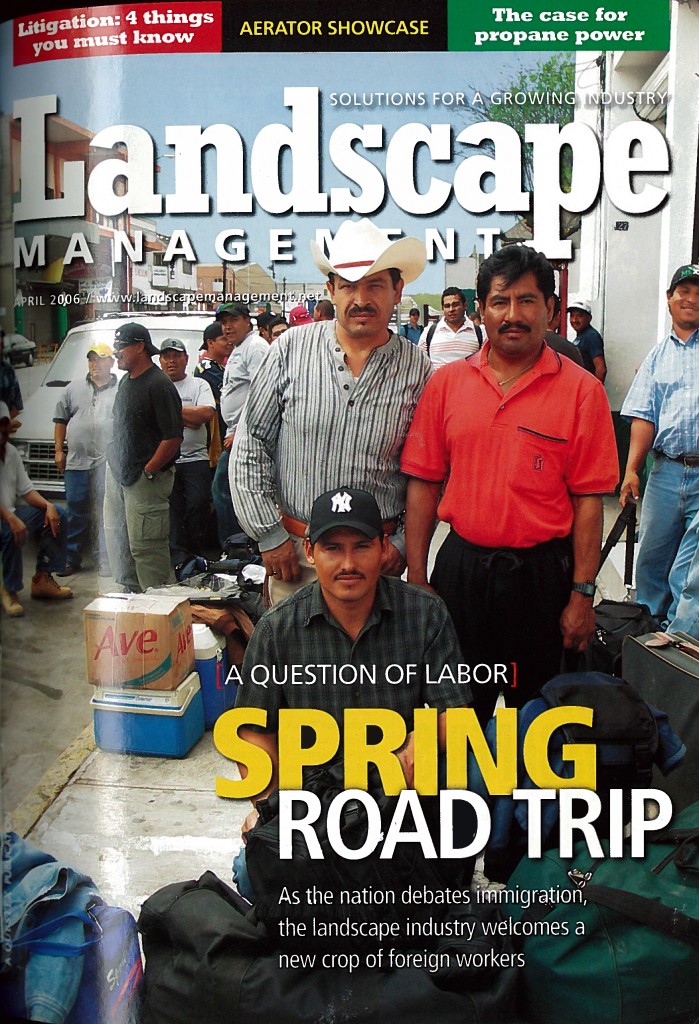 “In the pre-dawn glow of the security lights on Monterrey’s Ocampo Street, the hopefuls arrive, lugging duffel bags and pulling small suitcases behind them. Many spent the previous night in a nearby hotel. For $12 each they get a clean place to sleep four to a room and a couple of simple but filling meals. The overnight stay is needed because the work visa process here in this northern Mexican city usually takes two days.”
“In the pre-dawn glow of the security lights on Monterrey’s Ocampo Street, the hopefuls arrive, lugging duffel bags and pulling small suitcases behind them. Many spent the previous night in a nearby hotel. For $12 each they get a clean place to sleep four to a room and a couple of simple but filling meals. The overnight stay is needed because the work visa process here in this northern Mexican city usually takes two days.”
Ron Hall, then-editor-in-chief of Landscape Management, goes on to describe this scene as “a city of people within a city.” He was reporting from Monterrey, Mexico, located 120 miles south of the Texas border, for the article “Working in America,” the cover story of the April 2006 issue of LM.
Contrary to a federal mandate that no more than 66,000 H-2B worker visas were to be approved that year, according to the article, 2006 marked a change of a pace for the H-2B program.
It was the year a sub-classification of H-2B workers was introduced due to the passage of the Save our Small and Seasonal Businesses Act in 2005. That classification was H-2R. It applied to workers who had been a part of the H-2B program for at least three years, giving them somewhat of a “preferred” status in the program by basically guaranteeing their return to their seasonal U.S. employers, regardless of the federally mandated cap on the visas.
The new layer to the guest worker program was expected to more than double the number of H-2B visa applications in 2006 and, if extended by Congress, it would quadruple the number of H-2B visas by 2008, Hall reported.
Now, let’s return to Monterrey.
Some of the H-2B and H-2R “hopefuls” trekked 16 hours to get fingerprinted one day and go through a face-to-face interview the next. If approved, they’d be put on a bus that second day and shipped to the U.S.
The 18 American foreign service officers and more than 35 locally hired staff working in the consulate office were processing more than 2,000 visa applicants per day.
While these legal efforts to expand the availability of foreign workers in the U.S. were going on south of the border, in actuality there were many migrants in the U.S. already in 2006—11 million to 12 million unauthorized ones, according to the Pew Hispanic Center. The portion of those migrants who were illegally employed was not recorded, clearly.
Fast forward to 2014 and the H-2B program is still in place, albeit the H-2R component is not, and a solution is still needed for the abundance of illegal immigrants in the U.S.
In fact, the majority of the Green Industry says immigration policy needs to be fixed at a federal level.
In a recent immigration sentiments survey among members of the Green Industry, headed by LM and the Professional Landcare Network (PLANET), 81 percent of respondents said so and 75 percent also said they were in favor of a proposed policy that includes a roadmap for citizenship.
If the policy passed, this could be a triumph for the industry in terms of its labor woes. As Hall wrote in 2006, immigrant seasonal workers are “vital to the health and continued growth of the landscape industry.”

